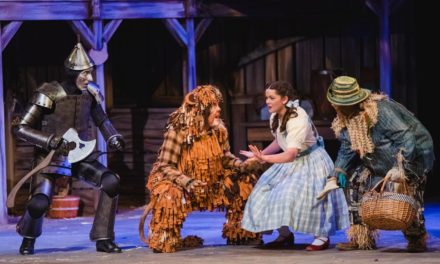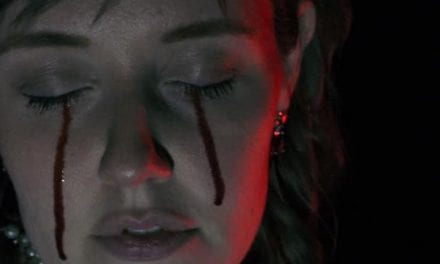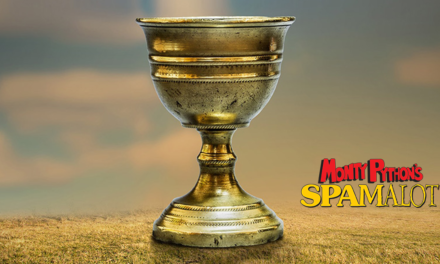SPANISH FORK — When Robert Louis Stevenson published Treasure Island in 1883, he probably did not foresee the number of adaptations his novel would spawn over the next century and a half. Generations have come to know Stevenson’s band of pirates through film, plays, comics, video games, and radio dramas. Now Cobb & Co Theatre presents a new musical written by John Cobb, directed by Ruthie Cobb, and based on the beloved, swash-buckling story.

Show closes August 6, 2022.
In Treasure Island, Jim Hawkins, a fatherless boy, wants to follow a map that leads to buried treasure. Jim’s mother, on the other hand, has other plans for him, which include him staying at the tavern she owns and accepting her boyfriend, Dr. Livesey, as his new father. Despite his mother’s wishes, the stubborn Jim and Dr. Livesey embark on a journey to find the treasure. A tale of adventure, fatherhood, and yellow-toothed piracy ensues.
I give the biggest kudos to Karrol Cobb for composing the score, which served as the show’s foundation. Most of the music — and especially one of the beginning numbers that had an accordion and a bouncy 3/4 meter — fit my expectations for a story of pirates. My favorite song, “Measure of a Man,” carved a compelling melody over an interesting progression of chords. The grandeur and intimacy of that song helped me understand the interior lives of Dr. Livesey and the pirate Long John Silver.
There were other times, however, when I could only vaguely understand the purpose of the song. That could have been an issue with the score, the dialogue in between, or the cast’s delivery. “Pirates Brass and Bold” exemplified the confusing parts of the show. When a band of pirates attacked Jim and Mrs. Hawkins in the tavern, they started off threatening their victims with swords as they growled their menacing song. Then partway through, the music lightened up and the pirates smiled and laughed. After another change, they ended the song with their swords again at the Hawkins’ necks. During this mess of energy shifts, Jim and his mother alternated between terrified and confused. The abrupt changes in character, which were more chaotic than comedic, also caught me off-guard.
Some of my other confusion came from the language of the script. I appreciated the wordplay — when I could understand it. For example, Mrs. Hawkins (played by Hannah Brown) quipped to her son that her tavern was full to the brim with men who had a physical compass and no moral one. Other than that moment, it could have been either the antiquated language or the thick accents (directed by dialect coach Hannah Tolman) that muddled the dialogue for me. Without a clear sense of what was being said, I had a hard time following the simple plot. Maybe the obscure vocabulary could have landed if the cast were as clever as the script, but I think plainer language would have made more sense with other elements in the show, like the acting.
Speaking of the acting, the most enjoyable times came from the melodrama. Matthew Delafuente as Trelawney sold his over-the-top choices, like when his fever-struck character broke out into a deranged outburst across the stage. The bits of physical comedy also lightened the mood. At one point, the grave Captain Billy Bones (played by Tommy Brown) sat in a chair and held Jim, who was standing, by the collar. In order for Jim (played by Jackson Harper) to be at the Captain’s height, Jim had to lean forward, causing his feet to continually slide out from under him. I could not help but laugh at the juxtaposition between the Captain giving Jim a stern warning and Jim treading his feet like he was walking in place. As for Harper, I applaud him for taking on a large role as a young actor. I hoped during the show that he would have been a little more present with the audience instead of fidgeting with his microphone or appearing distracted, though. Still, it was, overall, a great performance.
The design elements of the show creatively reinforced the narrative. As part of Erin Cobb’s costuming, Long John Silver’s peg leg consisted of a sock with wood print on it encased in a plastic, wood-printed tube that went up to his knee. A highlight from Hannah Tolman’s hair and make-up was Grace Clark’s convincing dreadlocks. There were some golden moments when the lighting by Gabi Pack and sound by John Cobb worked synergistically. In the tavern scene, I liked the sound of the crackling fire as a red light pulsed over the stack of wood. To simulate nighttime on the island, blue-green lights and the sound of crickets saturated the stage.
Overall, I think if the production team found some ways to help the script and cast mesh a little more, the story would come out more clearly. The show for me oscillated between indecipherable and infantile, but I am sure a happier medium could have easily been found. Additionally, I had a hard time swallowing the trope of the cannibalistic native (played by Jade Higley) and the poor imitation of a hijab during “Come Sinbad.” Hopefully, future adaptations of Stevenson’s novel will leave behind the culturally insensitive elements of the source text.
That said, audiences looking for an adventure on the seven seas will not be disappointed by Treasure Island. Even though it’s not perfect — if such a thing as perfection exists in theatre — Cobb & Co’s rendition of this classic story offers exciting new music and plenty of laughs. Families will not want to miss the fearless Jim Hawkins enter the world of pirates. All aboard!





